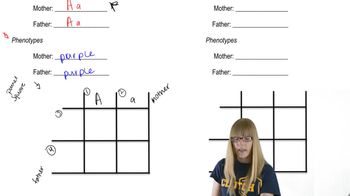Table of contents
- 1. Introduction to Genetics51m
- 2. Mendel's Laws of Inheritance3h 37m
- 3. Extensions to Mendelian Inheritance2h 41m
- 4. Genetic Mapping and Linkage2h 28m
- 5. Genetics of Bacteria and Viruses1h 21m
- 6. Chromosomal Variation1h 48m
- 7. DNA and Chromosome Structure56m
- 8. DNA Replication1h 10m
- 9. Mitosis and Meiosis1h 34m
- 10. Transcription1h 0m
- 11. Translation58m
- 12. Gene Regulation in Prokaryotes1h 19m
- 13. Gene Regulation in Eukaryotes44m
- 14. Genetic Control of Development44m
- 15. Genomes and Genomics1h 50m
- 16. Transposable Elements47m
- 17. Mutation, Repair, and Recombination1h 6m
- 18. Molecular Genetic Tools19m
- 19. Cancer Genetics29m
- 20. Quantitative Genetics1h 26m
- 21. Population Genetics50m
- 22. Evolutionary Genetics29m
2. Mendel's Laws of Inheritance
Monohybrid Cross
Problem 12d
Textbook Question
Using the information provided in Problems 10 and 11, determine the genotype and phenotype of parents that produce the following progeny:
27/64 brown : 16/64 albino : 9/64 yellow : 9/64 black : 3/64 cream
 Verified step by step guidance
Verified step by step guidance1
<span>Step 1: Identify the phenotypic ratio of the progeny. The given ratio is 27:16:9:9:3 for brown, albino, yellow, black, and cream, respectively.</span>
<span>Step 2: Recognize that these ratios suggest a dihybrid cross involving two genes, each with two alleles. The phenotypic ratio of 27:16:9:9:3 is a modification of the typical 9:3:3:1 ratio seen in dihybrid crosses.</span>
<span>Step 3: Assume that the two genes involved are A and B, where A and B are dominant alleles, and a and b are recessive alleles. The albino phenotype (16/64) suggests a recessive epistasis, where the presence of two recessive alleles (aa) masks the expression of the other gene.</span>
<span>Step 4: Determine the genotypes that correspond to each phenotype. For example, brown could be A-B-, albino could be aa--, yellow could be A-bb, black could be aaB-, and cream could be aabb.</span>
<span>Step 5: Use the phenotypic ratios to deduce the genotypes of the parents. The presence of all phenotypes suggests that the parents are heterozygous for both genes, likely AaBb x AaBb.</span>
Recommended similar problem, with video answer:
 Verified Solution
Verified SolutionThis video solution was recommended by our tutors as helpful for the problem above
Video duration:
1mPlay a video:
Was this helpful?
Key Concepts
Here are the essential concepts you must grasp in order to answer the question correctly.
Genotype
Genotype refers to the genetic constitution of an organism, specifically the alleles it possesses for a particular trait. In this context, understanding the genotype is crucial for predicting the phenotypic ratios of the progeny. The genotype can be homozygous (two identical alleles) or heterozygous (two different alleles), and it directly influences the observable traits in the offspring.
Recommended video:
Guided course

Gamete Genotypes
Phenotype
Phenotype is the observable physical or biochemical characteristics of an organism, determined by both its genotype and environmental factors. In the given question, the phenotypic ratios of the progeny (brown, albino, yellow, black, and cream) provide essential clues to deduce the parental genotypes. Understanding how different genotypes manifest as distinct phenotypes is key to solving the problem.
Recommended video:
Guided course

Mutations and Phenotypes
Punnett Square
A Punnett Square is a diagram used to predict the genetic outcomes of a cross between two organisms. It helps visualize the possible combinations of alleles from the parents and the resulting genotypes and phenotypes of the offspring. Utilizing a Punnett Square can clarify how the observed ratios of progeny relate to the genotypes of the parents, making it a valuable tool in genetic analysis.
Recommended video:
Guided course

Chi Square Analysis

 1:20m
1:20mWatch next
Master Monohybrid Cross with a bite sized video explanation from Kylia Goodner
Start learningRelated Videos
Related Practice


